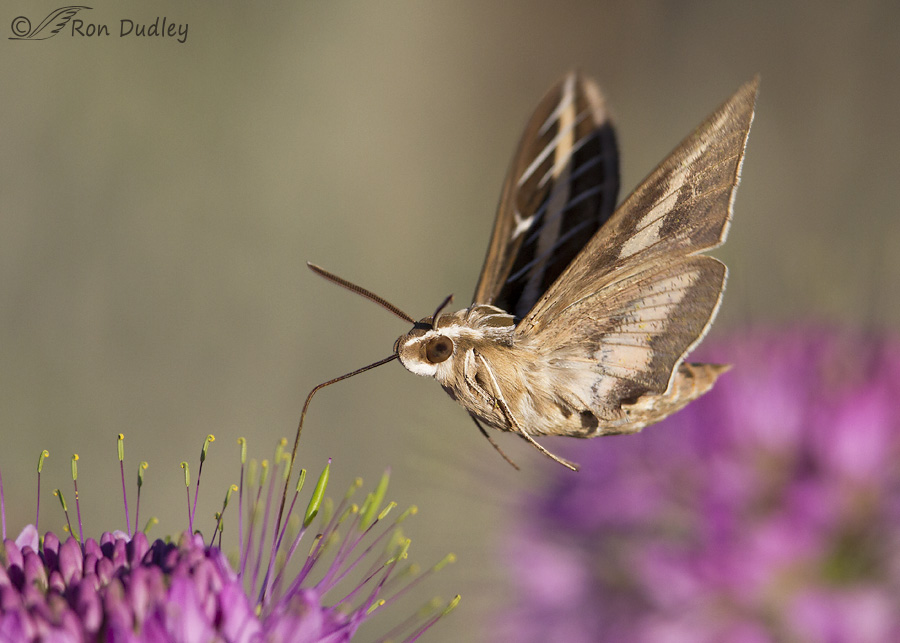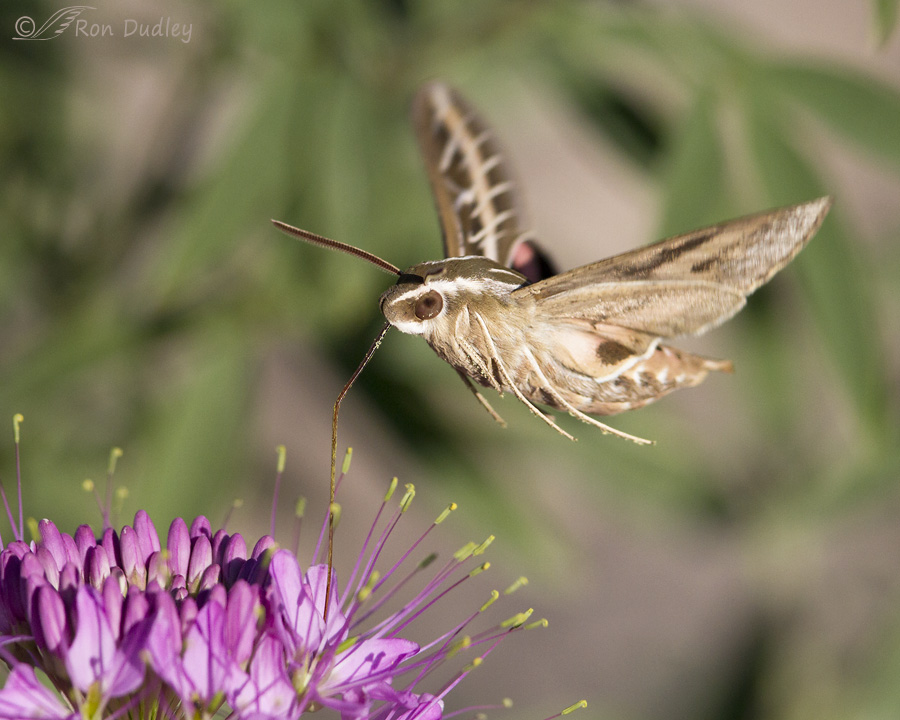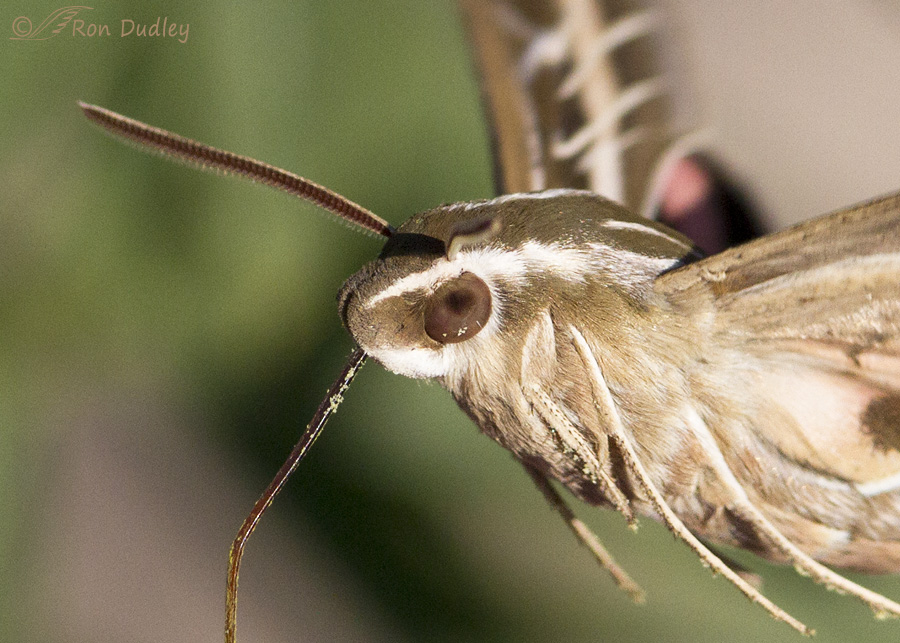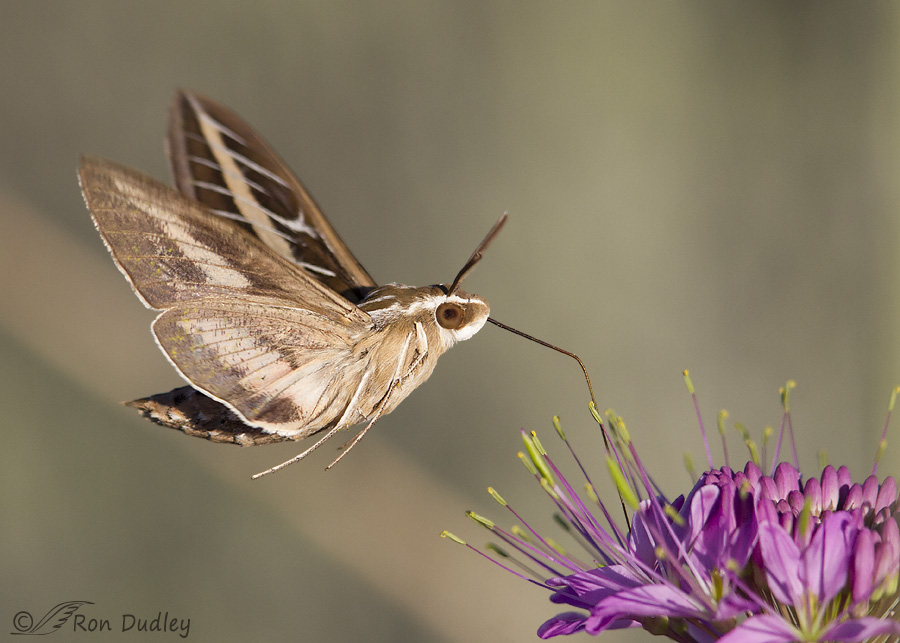I decided to feature birds of a different feather this morning – Hummingbird Moths in flight.
They’re often called Hummingbird Moths because they hover in the air as they feed on flower nectar just like hummingbirds do but the proper common name of the species I photographed is White-lined Sphinx Moth. Because of their fairly large size and feeding habits they’re often mistaken for hummingbirds. I spent several mornings with them back in August of 2014.
 1/3200, f/5.6, ISO 640, Canon 7D, Canon EF 500mm f/4L IS II USM + EF 1.4 III Extender, not baited, set up or called in
1/3200, f/5.6, ISO 640, Canon 7D, Canon EF 500mm f/4L IS II USM + EF 1.4 III Extender, not baited, set up or called in
The moths would use their very long proboscis to feed on the nectar of Rocky Mountain Bee Plant on Antelope Island. Photographing them well in flight was a difficult task but I really enjoyed the challenge and even got some images of them I like very much.
 1/4000, f/5.6, ISO 640, Canon 7D, Canon EF 500mm f/4L IS II USM + EF 1.4 III Extender, not baited, set up or called in
1/4000, f/5.6, ISO 640, Canon 7D, Canon EF 500mm f/4L IS II USM + EF 1.4 III Extender, not baited, set up or called in
Because of the speed of the wings and my extremely limited depth of field at these close distances I often had great difficulty getting the entire insect sharp. In this photo only the head is sharp so I thought about tossing the image until I looked at an extreme crop of the photo.

This version of the previous shot is cropped to only 7.5% of the original image (1.5 MP of the original 20 MP). I enjoy the detail such a crop allows us to see including the pollen stuck to its body from its feeding activities. Notice that there’s pollen actually clinging to its eye.

1/2500, f/5.6, ISO 640, Canon 7D, Canon EF 500mm f/4L IS II USM + EF 1.4 III Extender, not baited, set up or called in
Occasionally I could get most of the moth sharp so I like this image a lot despite the diagonal light-colored band in the background. It was fascinating to watch that incredibly long proboscis fold up into a compact little coil under its “chin” but I got very few quality images with it in a coiled position.
I’ve been watching for these moths on the island for the past two summers but there’s been very little bee plant so I haven’t seen any moths since 2014.
Ron


Ron, You do everything well.
Stephen
Really like these guys and gals. Had never seen them until I planted Butterfly bushes which they visit every day. Look forward to seeing them. Thanks for the great pics.
Soooooo totally cool, Ron!!! I love these shots. I like the band of light because it mirrors the banding pattern on the wings.
The 7.5% crop is my favorite, in part because of seeing the pollen grains on the eye and proboscis, but even moreso because it looks like the moth has EYELASHES! Holy smokes!
Thank you for taking my mind off the short list for Secretary of Education, even for a little while.
Those fine, dark “hairs” do almost look like eyelashes, don’t they?
I find the Moth’s interesting. We see them here now and then. I love how you captured the beauty!
Thanks, Jean.
Awe and wonder.
And gratitude that you slowed your culling trigger finger.
Thank you, EC.
I always enjoy seeing White-lined Sphinx Moths – I think they were my introduction of Sphinx Moths. When I was living in Virginia we had Hummingbird Moths with clear wings, which are much smaller than this guy, but still quite spectacular. Moths or butterflies (or Coyotes) are a nice change of pace, even though I never get tired of birds.
“Moths or butterflies (or Coyotes) are a nice change of pace, even though I never get tired of birds”
If it’s a critter I’ll photograph it, Susan. And if the images are any good I’ll likely post them…
Love those spinx moths!!!!! They feed on my zinnias!! I didn’t have any this year though. I didn’t have a tomato patch. I usually have my Freind farmers bring me they’re Tomato worms. I asked them not to kill them but bring them to my tomato patch lol. Next year will grow a tomato patch just for them . I have hundreds of pictures and just love them!!!
Love hearing about the lengths you’re willing to go to have them around, Marina!
Sensational series Ron!
Charlotte
Thanks, Charlotte.
Beautiful!! Great shots, love em!!
Wish I could get pictures up close and personal of our hummingbird moths, but believe they are smaller then yours.
Dick, in the last shot in this post (link below) you can judge the size of our moths because there’s both a moth and a hummingbird in the same photo.
https://www.featheredphotography.com/blog/2016/01/06/white-lined-sphinx-moths-in-flight/
WOW!! And I commented on that post as well. Man, where is my memory going-going-gone?
Your right, a significant difference in size! Now what I need to do next summer, if I can remember, is to try and shoot a clearwing moth and a hummer at the same time!!
Many thanks.
Dick, I think your memory is just fine. Hell, they’re MY images and I often forget which ones I’ve posted!
OH Wow!! Just beautiful!
Thanks, Judy.
Hummingbirds are uncommon to rare in Interior Alaska, but a couple of times a summer there would be reports of “hummingbird” at someone’s flowers. It was almost always a hawk moth of some kind. Excellent photos, Ron.
WC, I should have mentioned that hummingbird-hawk moth is another name variation for these insects. Thank you.
I remember seeing my first one in my yard when I lived in Pocatello. I was pretty excited about! Haven’t seen any since. Beautiful photos as always.
Thanks very much, Kathy.
Awesome photos. I have tried to photograph them outside the butterfly habitat where I volunteered last summer. It was impossible for me to catch without motion. These are amazing shots! The flower looks very much like what we call spider plants in central Illinois.
Yes, they’re very difficult to photograph in flight, Cindy. My “keeper” rate was atrocious – most images ended up in the trash heap.
How atrocious? Make us all feel better :>) 50 to 1, or more like a 100 to 1
Beautiful! We once mistook one for a hummingbird – the do appear that way at first glance! Definitely a challenge to photography and you “nailed it”
Judy, After spending so much time with these moths it’s easy to see how they could be mistaken for hummingbirds. They even act like hummingbirds – more than once I saw a moth attack hummingbirds and drive them off “their” flower patch.